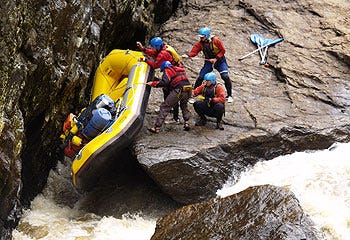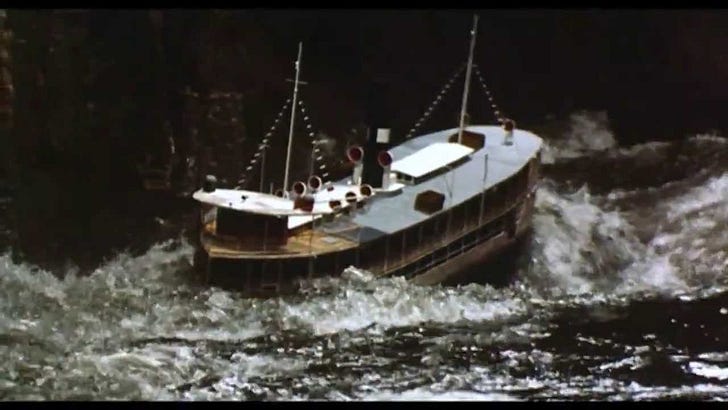
In December of 2017, seven of us ventured to Tasmania, once known as Van Diemen’s Land, to boat a river only one of us had ever heard of before this trip was planned - the Franklin River. This is our story. It will take several ‘parts’ for me to tell it. I’ll post a ‘part’ - whenever I can - until the story, from my perspective, is complete.
Our trip down the Franklin, and a short, but memorable section of the Gordon, was 129 kilometers long. About 80 miles in American terminology. It’s a trip that should, under normal conditions, require a week to eight days. An aggressive, skilled kayaker could manage it in four days. We were advised to allow 11 to 12 days in the event the weather and the river decided to have a high water event as we had seen via the graphs before we had launched.
The Great Ravine is one section of that journey, a very short section actually, but it harbors the most serious whitewater and back-breaking portages. Within the Great Ravine are four rapids of consequence: The Churn, The Coruscades, Thunderush and the Cauldron. Each need to be approached with an abundance of caution because a mistake with any of them could be fatal.
It’s imperative you reach and portage the third monstrous rapid in the gorge - Thunderush - when the river is not varying high. Because the only portage is along the shore over massive boulders on river left while the water level is on the calmer side. An old high water portage on the right bank, involving humping your gear over land, above the cliffs and through the forest had been eliminated some years back by a rock slide.
I am going to be honest with you.
I can’t tell you what any of the four major whitewater declivities in The Great Ravine look like - in any detail - because I never bothered to look at them. I knew from the start of our trip down the remote Franklin River in the most remote part of Tasmania that, if there was even the slightest possibility of taking the overland option, I was going to do so.
I did take a cursory glance at The Coruscades, the rapid where the Aussie company replete with many experienced Franklin guides was camped and where a few of their folks sat leisurely in their camp chairs and cheered us on, but when my partner declared there was no chance in hell he was going to paddle it, he provided me with the perfect “out”.
Fortunately, we had two group members willing to paddle those rapids twice.
Fortunately, the rapid’s configuration allowed them to paddle their raft through and then walk back up to the initiation eddy and do it all over with my raft.
Fortunately, nothing went awry on their first paddle through to prevent them from doing so.
My paddle partner and I had more than enough skills and experience, of course, we just didn’t pack the temerity. Having mastered my whitewater skills in an era of boats that had to be bailed with a five gallon plastic bucket, I mastered the art of avoidance boating. ‘Avoidance’ boating was a necessary skill in the era of non-self-bailing rafts, unless your idea of a good time was trying to steer a few tons of rubber and water around unforgiving rocks and potential boat-flipping reversals. Or being in control was low on your survival priority list.
When avoidance was not on the whitewater menu, my comfort level was quickly breached.
The upper section of The Coruscades rapid concluded with a deep dive into a wave that engulfed our relatively petite two-person boats. A mishap there might mean a swim of varying length through a series of mini-waterfalls. (I described those waterfalls in the previous column on the Ever Varying Flood subtitled Mr. Toad’s Wild Ride). Avoidance boaters, like myself, who have a Master’s degree in avoiding things, are not fond of ‘swimming’.
So, now with the ugliest portion of Thunderush Rapids upstream of us, safely in our rearview mirror so to speak - Thunderush being the lone rapid in The Great Ravine that we could not skirt via a ‘track’ on shore - I breathed a heavy, exhausted sigh of relief. I understood from all of the descriptions given us by the local boaters and guide books that I would have the option to take the track around The Cauldron - ostensibly the nastiest cacophonous collection of boulders and rushing whitewater we were to encounter on the Franklin River.
As I said at the beginning, I never looked closely at any of the whitewater The Great Ravine had to offer. And I wasted no amount of anxiety eyeballing the final drop, The Cauldron, because I knew I wasn’t going to try to navigate it. I didn’t feel the need to know it intimately, like just about every rapid of consequence I have faced. If I wasn’t going to navigate it, I didn’t need it indelibly imprinted upon my brain.
But, the next day, when I stood safely below it calmly watching my fellow boaters do what’s depicted in the picture at the top, what it reminded me of from afar, was a medieval castle made from the most massive blocks of stone you could imagine. And the whole structure had sunk and collapsed in on itself, but some of the archways and turrets had left openings for a sea of water to rush through haphazardly in every direction possible. And everywhere you looked the water was turbulent and tortured and tumbled back on itself or smashed against a wall of stone before it finally found its way out of the imploded castle ruins.
But, I am jumping ahead because the effort it took to get one raft around The Cauldron and through a jungle of matted roots, hanging vines and a vertiginous trail was epic. As in epically hazardous and I am not even including the ground leeches in that estimation.
It reminded me of Werner Herzog’s film Fitzcaralldo.
###
To get a feel for what I will be describing in the next addition to this tale, you should really watch the Fitzcarralldo movie trailer.
Also, here is another classic Herzog film which is where the name for the monstrous wave at the top of the Wenatchee River’s Boulder Bend Rapids comes from - Aguirre: The Wrath of God. Interesting that both Herzog films are set in South America. It humors me to think about the German actors playing Spanish conquistadors speaking German with English subtitles.
Lest you think all of Herzog’s movies are bizarrely unwatchable and set in South America - and Werner Herzog is a prolific director of movies - the last one I’ll leave you with is Grizzly Man. Two thumbs up.



